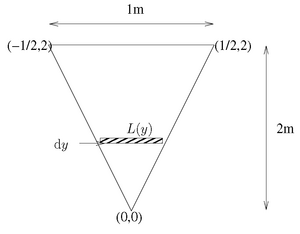Science:Math Exam Resources/Courses/MATH101/April 2009/Question 07 (a)
{{#incat:MER QGQ flag|{{#incat:MER QGH flag|{{#incat:MER QGS flag|}}}}}}
• Q1 (a) • Q1 (b) • Q1 (c) • Q1 (d) • Q1 (e) • Q1 (f) • Q1 (g) • Q1 (h) • Q1 (i) • Q1 (j) • Q2 • Q3 (a) • Q3 (b) • Q4 (a) • Q4 (b) • Q5 • Q6 (a) • Q6 (b) • Q7 (a) • Q7 (b) • Q7 (c) • Q8 (a) • Q8 (b) •
Question 07 (a) |
|---|
|
An open metal tank has two ends which are isosceles triangles with vertex at the bottom, two sides which are rectangular, and an open top. The tank is 1 metre wide, 2 metres deep, 10 metres long and full of water (density = 1000 kg/m3).
|
|
Make sure you understand the problem fully: What is the question asking you to do? Are there specific conditions or constraints that you should take note of? How will you know if your answer is correct from your work only? Can you rephrase the question in your own words in a way that makes sense to you? |
|
If you are stuck, check the hints below. Read the first one and consider it for a while. Does it give you a new idea on how to approach the problem? If so, try it! If after a while you are still stuck, go for the next hint. |
Hint 1 |
|---|
|
Recall that hydrostatic pressure is given by, where is the density of water, g, the gravitational constant, and h the height from the top. It is important that height is measured from the top of the surface because as depth increases, there is more water above you, increasing to the pressure. |
Hint 2 |
|---|
|
Recall that they hydrostatic force on an object of area A at height h is where is the density of the surrounding liquid. |
|
Checking a solution serves two purposes: helping you if, after having used all the hints, you still are stuck on the problem; or if you have solved the problem and would like to check your work.
|
{{#incat:MER CT flag||
}}











